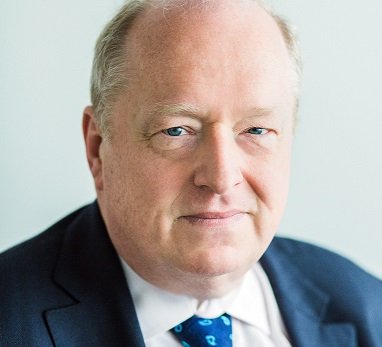The London Collective Investment Vehicle’s new chief executive talks to Peter Findlay about managing relationships with local authorities, the challenge to government guidance and making a success of the LCIV.

Room151: Having been in the job for six weeks, what are the specific challenges you’re facing?
Mike O’Donnell (MO’D): I was involved in some of the very early discussions with the Society of London Treasurers on establishing the CIV (collective investment vehicle) and looking back, I’d say some really good progress has been made. The fact that we’re now over 50% of assets under management (AUM) I think is a really positive thing and shows great progress, but there’s further to go.
In terms of those immediate challenges, firstly we want to launch more funds, provide more choice to the London Local Authorities (LLAs)n, and ensure that those funds are launched on time.
One of the challenges has been hitting fund launch deadlines, so we’re focusing on improving that.

Of course, a perennial challenge of ours is that we have 32 shareholders and 32 potential investors. The other pools are much smaller with eight or nine members. Working with 32 shareholders and investors is always going to have its challenges; the pool being aligned to what the funds are trying to achieve with their investment strategies, and making sure we’ve got everything lined up for them, is a key objective.
Obviously then there is the uncertainty around the economy and Brexit which makes it a very interesting time, and also the fact we’re coming up to a triennial valuation means authorities will be re-thinking their asset allocation strategies. That may be a good thing as it opens up the potential for new fund launches, but there’s also the risk of delay as LLAs think through their strategies.
R151: So, in terms of asset allocation, how likely is it that the CIV is ever going to produce a suite of products that fits 32 changing strategies?
MO’D: You’re never going to get it to 100% but I do think if you start with the belief that collaboration is a good thing rather than LLAs going off and doing something 33 times over, then that’s a very good starting point.
The LLAs are different but they’re also quite similar in a lot of ways. They have fairly similar sets of liabilities, they vary a bit in terms of funding levels and risk appetite but actually there aren’t that many variations. I do think over time, the CIV can get to a point where it is offering by far the majority of the investment vehicles that our clients need.
There will always be a space for local investments, as the new guidance sets out, and there will always be a space for LLAs wanting to do something differently.
I wouldn’t want to put a number on it. The government talks about 95% [of AUM to sit with the pools] in its latest guidance, which I think is probably unrealistic. Certainly though, a fairly significant percentage is going to be in pretty mainstream assets like equities, fixed income, infrastructure and private equity, and actually having CIV options on the table that clients can draw down on, negotiated on the basis of scale and meaningful fee reductions, will I believe prove attractive.
R151: You mentioned local investments there, would you expect those to be predominantly in housing?
MO’D Yes. The whole issue of investment in local assets – infrastructure and housing in particular – is an issue that played out through earlier discussions in the formations of the pools. Clearly there has to be a sound investment case but if you can use pension fund assets to deliver both a good financial return and to help with the housing crisis, then I think that’s a good thing and I know that many of our clients are interested in looking at that option.
R151: Can the CIV provide help with housing investment?
MO’D: I think in time, yes. The challenge with doing it on an individual basis is that A), you potentially won’t have the scale and B), you won’t have the ability to diversify, which a London-wide vehicle could offer.
R151: Would you pretty much expect to get to the stage where authorities are not placing any investments directly?
MO’D: That’s the whole direction of travel. MHCLG in its guidance is talking about as little as 5% of AUM to reside with administering authorities by 2020 but I think that’s a little ambitious, as I’ve said.
But look, the London CIV was created by the boroughs and City of London – it was their baby, their creation – so I think it is about moving that agenda forward and that does mean more collective investment.
R151: Recently we’ve seen the three administering authorities of the Northern pool challenge the guidance on the basis it undermines value for money. How does the CIV see that issue?
MO’D: The guidance is at the draft stage so it does depend how it’s implemented. I think the risk of it undermining the wider fiduciary duty is a question of it being pushed too far and too fast. If individual funds are forced to make investment decisions that end up costing them money, then of course that’s going to create a problem.
So there’s a risk that administering authorities are compelled to make detrimental decisions purely so that they can hit government targets and that doesn’t make sense.
This is all about delivering better value for money for the taxpayer and that’s therefore about a combination of fee reductions and improved performance, so I do not think that any of our clients should be moving ttheir assets just for the sake of hitting a pooling number. It should be driven by a sensible investment strategy and an underlying strategy to improve the funding.
R151: Do you think there will be some London boroughs looking at Northern’s legal argument and taking a close interest?
MO’D: Well, as I say, I don’t think there are any London treasurers who are going to allow pooling to push them into making a decision that they believe is bad for their fund. They’re experienced professionals and they know what they’re doing.
The risk is, and I don’t think this is very likely, that the government takes a very hard line.
We’re some way off the guidance targets now, we’re on average at 47% capacity – so we’ve got quite a lot of headroom.
We’ve got a pretty careful and measured strategy around building new fund launches, and working with boroughs on fund launches so that we’re not pushing or forcing anyone into investments. I am really only interested in a conversation with individual shareholders and investors, it’s about meeting their investment requirement rather than relying on a mandatory approach and trying to drag anyone kicking and screaming into investments.
R151: Was there an issue before, do you think, in communicating with the Society of London Treasurers (SLT)? Is your appointment all about improving that?
MO’D: It’s certainly one of my main priorities. In recent times, and before my arrival, I think that had got better. For example, the way we work with boroughs on fund launches, having lots of conversations with them, trying to take them with us and be driven by their investment strategy and investment requirements.
I think that has got a lot better over the last six to twelve months but it’s clear that more can be done. I think it’s absolutely right that one of the reasons I’ve been hired is my background and strong connections with the boroughs. I am spending an awful lot of time talking to colleagues and certainly at a treasurer level who I know very well and worked with before.
I’ve got a commitment to spend at least a day a week out and about, whether that’s going and attending pension funds or pension fund committees or meeting pension fund chairs, finance directors or pensions managers in the boroughs, listening to their concerns and hopefully helping to develop a strategic way forward with them.
R151: What has the transition been like for you moving from local government finance broadly to managing an investment company?
MO’D: Interesting and a big learning curve. Of course, as a longstanding London borough finance director I’ve got quite a lot of experience of running an independent pension fund for 13 years; a fund of about £1.4bn when I left. There I did a lot of work on appointing fund managers so there’s a lot of relevant experience in what I was doing previously. The learning curve for me and the difference in the CIV is the FCA regulation and the fund launch process, so it’s very different when you’re, in a sense, investing your own money in a London borough versus investing and managing funds across 32 boroughs potentially. That comes with a whole heap of regulations and just a complexity around launching a fund and getting in and out of a fund at different points, unitising the fund for example. So it’s just much more complex but actually the overall objectives are still the same.
R151: What are you looking for in your new CIO?
MO’D: So, we are live on recruiting a CIO. We advertised in the Sunday Times a few weeks ago and final interviews are in the middle of May. It’s a really important appointment for me. In effect the previous interim CEO also covered the CIO role and the CIV wanted to wait until there was a permanent CEO in place before recruiting for the CIO role.
Obviously, it’s a priority because I don’t have that mainstream financial services background, so having somebody who’s got that is really important.
Essentially, we’re looking for someone who can bring that investment management expertise and credibility but has the skills and the ability to work with shareholders and investors. They have to be able to work with local boroughs and shareholders/investors, be able to understand what the drivers are from their point of view, and work with them to develop a set of products that meet their requirements.
R151: Could that be a local authority person do you think?
MO’D:I think it would have to be somebody that had FCA regulated experience but that could be someone currently working in a local authority.
R151: What do you think success will look like for yourself and for the London CIV?
MO’D: It really comes down to the issue we started on of relationships. I want the CIV to be the investment route of choice for the boroughs. I mean the [AUM] number itself isn’t important but clearly we’d like to see more funds coming through the CIV, and so it’s important that the relationships between the CIV and the boroughs, that have been a bit strained at times, are put at the centre of what we do here.
Mike O’Donnell is chief executive of the London Collective Investment Vehicle











